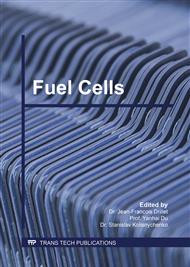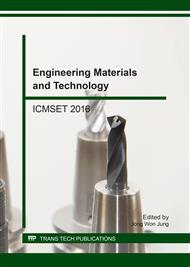[1]
B. Han, Stuart M. Steen III, J. Mo, F. Y. Zhang, Electrochemical performance modeling of a proton exchange membrane electrolyzer cell for hydrogen energy, Int. J. Hydrogen Energy 40(22) (2015) 7006-7016.
DOI: 10.1016/j.ijhydene.2015.03.164
Google Scholar
[2]
H. Gorgun, Dynamic modeling of a proton exchange membrane (PEM) electrolyzer, Int. J. Hydrogen Energy, 31(1) (2006) 29-38.
DOI: 10.1016/j.ijhydene.2005.04.001
Google Scholar
[3]
S. Karimi, N. Fraser, B. Roberts, Frank R. Foulkes, A review of Metallic Bipolar plates for Proton Exchange Membrane Fuel Cells: Materals and fabrication Methods, Adv. Mater. Sci. Eng. 2012 (2012), Article ID 828070, 22pages.
DOI: 10.1155/2012/828070
Google Scholar
[4]
N. Mohammadtabar, M. Bakhshi-Jooybari, S. J. Hossseinipour, A. H. Gorji, Feasibility study of a double-step hydroforming process for fabrication of fuel cell bipolar plates woth slotted interdigitated serpentine flow field, Int. J. Adv. Manuf. Technol. 85(1) (2016).
DOI: 10.1007/s00170-015-7960-y
Google Scholar
[5]
L. Xianguo, S. Imran Sabir, Review of bipolar plates in PEM fuel cells: Flow-field designs, Int. J. Hydrogen Energy, 30(4) (2005) 359-371.
DOI: 10.1016/j.ijhydene.2004.09.019
Google Scholar
[6]
A. Heinzel, F. Mahlendorf, C. Jansen, Bipolar plates, University of Duisburg-Essenm Duisburg, Germany 2009 Elsevier.
Google Scholar
[7]
J. C. Hung, C. C. Lin, Fabrication of micro-flow channels for metallic bipolar plates by a high-pressure hydroforming apparatus, J. Power Sources, 206 (2012) 179-184.
DOI: 10.1016/j.jpowsour.2012.01.112
Google Scholar
[8]
M. B. Osia, S. J. Hosseinipour, M. Bakhshi-Jooybari, A. Gorgi, Forming Metallic Mirco-feature bipolar plates for Fuel Cell Using Combined Hydroforming and Stamping Processes, Iranica J. Energy Environm. 4(2) (2013) 91-98.
DOI: 10.5829/idosi.ijee.2013.04.02.03
Google Scholar
[9]
X. Z. Yuan, H. J. Wang, J. J. Zhang, David P. Wilkinson, Bipolar plates for Fuel Cells-Form Materials to processing, J. New Mater. Electrochem. Syst. 8(4) (2005) 257-267.
Google Scholar
[10]
H. G. Kim, H. J. Shin, Y. J. Cha, S. H. Ko, H. W. Kim, L. K. Kwac, Stability Evaluation for Polymer Electrolyte Membrane Electrolyzer, Appl. Mech. Mater. 260-261 (2012) 443-448, ISSN: 1662-7482.
DOI: 10.4028/www.scientific.net/amm.260-261.443
Google Scholar
[11]
T. Alexandre, Analysis of polymer electrolyte membrane (PEM) electrolyzer performance using 3-D mesh, Master's thesis, Dept. of Mechanical Eng, Jeonju University, Jeonju-si, South Korea (2016).
Google Scholar
[12]
D. H. Jeon, S. Greenway, S. Shimpalee, J. W. Van Zee, The effect of serpentine flow field designs on PEM fuel cell performance, Int. J. Hydrogen Energy, 33(3) (2008) 1052-1066.
DOI: 10.1016/j.ijhydene.2007.11.015
Google Scholar
[13]
COMSOL Inc., Mass Transport analysis of a High Temperature PEM Fuel Cell, https: /www. comsol. com/model/mass-transport-analysis-of-a-high-temperature-pem-fuel-cell-8550 (Accessed 26 MAY 2016).
DOI: 10.1016/b978-012374259-9.50006-9
Google Scholar
[14]
COMSOL Multiphysics User's Guide. http: /people. ee. ethz. ch/~fieldcom/pps-comsol/documents/User%20Guide/COMSOLMultiphysicsUsersGuide. pdf.
Google Scholar
[15]
T. Alexandre, H. J. Shin, S. H. Go, M. S. Lee, L. K. Kwac, H. G. Kim, Electrochemical performance analysis of a PEM water electrolysis with cathode feed mode based on flow passage shape of titanium plates, Int. J. Precis. Eng. Manuf. 17(8) (2016).
DOI: 10.1007/s12541-016-0130-9
Google Scholar



